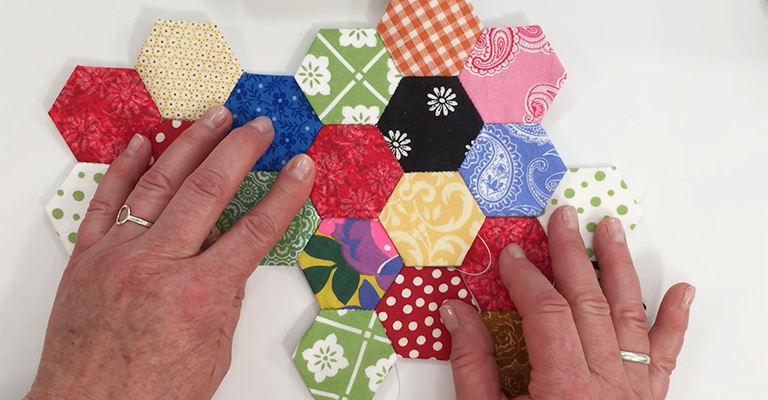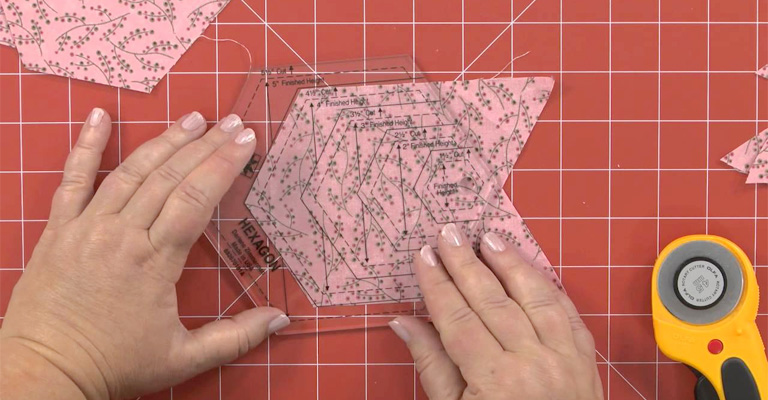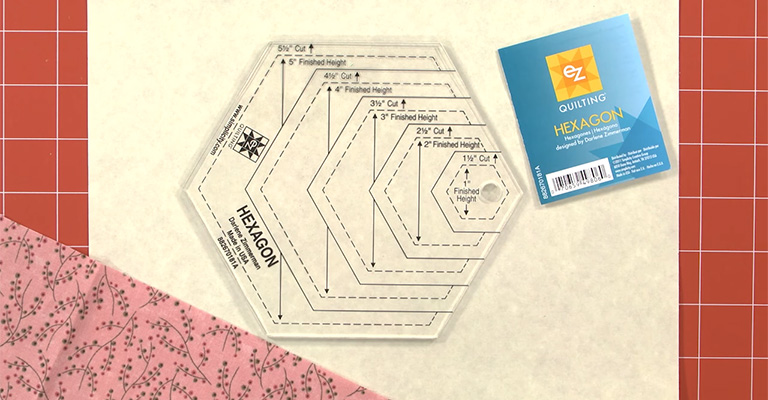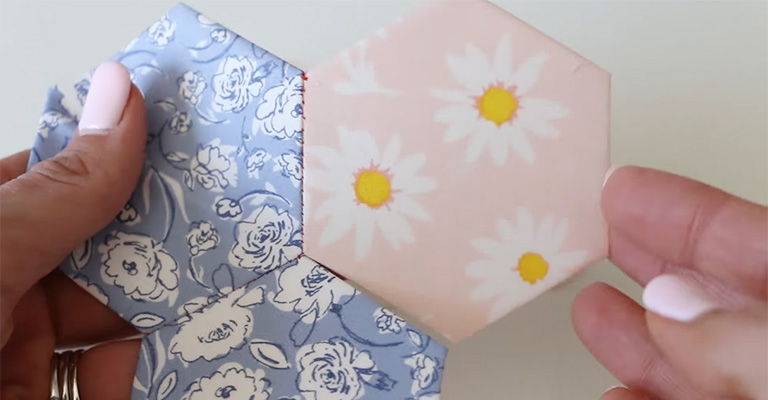In the world of quilting, precision and accuracy are paramount, and one of the fundamental aspects of achieving a stunning hexagon quilt design is learning how to measure a hexagon correctly.
Hexagons, with their six sides and seemingly endless design possibilities, have been a beloved shape for quilters for generations.
Whether you’re creating a classic Grandmother’s Flower Garden pattern or a modern geometric masterpiece, understanding how to measure hexagons for quilting is essential.
The process involves considering factors like your desired quilt size, pattern intricacy, and seam allowances, all of which directly impact the size of your hexagons.
In this exploration, we’ll delve into How to Measure a Hexagon For Quilting which will empower you to measure hexagons accurately, ensuring your quilting project turns out beautifully.

Hexagon For Quilting?
Hexagons are a popular and timeless geometric shape used in quilting to create visually captivating and intricate designs. These six-sided polygons add a unique dimension to quilts, allowing quilters to explore their creativity and design skills.
Hexagon quilting involves cutting fabric pieces into hexagonal shapes and then sewing them together in various patterns. The most common method for creating hexagon quilts is English paper piecing, where a paper template is used as a foundation for each hexagon.
Quilters wrap the fabric around the paper templates, stitch them together, and then remove the paper when the hexagons are securely joined. This technique results in precise and uniform hexagons.
Hexagon quilts can feature a single, repeating hexagon pattern or more complex designs like the Grandmother’s Flower Garden pattern.
The versatility of hexagons allows for endless possibilities, making them a beloved choice for quilters looking to showcase their skills and produce stunning, eye-catching quilts.
Whether in traditional or contemporary styles, hexagon quilts add a timeless elegance to the world of quilting.
How To Measure A Hexagon For Quilting?

Measuring a hexagon for quilting requires precision to ensure your quilt pieces fit together perfectly. Here are the simple methods for measuring hexagons:
Paper Templates
The most common method is to use paper hexagon templates. These templates come in various sizes and are readily available at quilting stores. You can choose the size that suits your design, trace it onto your fabric, and cut around the template.
Rotary Cutter and Ruler
If you prefer a more precise and efficient approach, use a rotary cutter and a hexagon ruler. The ruler has markings for different hexagon sizes, making it easy to cut accurately.
Hexagon Quilting Ruler
Invest in a hexagon quilting ruler, which is specifically designed for measuring and cutting hexagons. These rulers often include additional features like seam allowances, ensuring precise measurements.
Hexagon Acrylic Template
Acrylic templates are durable and easy to use. Simply place the template on your fabric and cut around it with a rotary cutter.
Printed Hexagon Fabric
Some quilting fabric comes with pre-printed hexagon shapes. These fabrics are designed for hexagon quilting, allowing you to cut along the printed lines.
Computer-Aided Design (CAD)
If you’re using quilting software or CAD programs, you can design hexagon shapes digitally and print out templates with precise measurements for cutting.
Freehand Drawing and Scissors
If you have steady hands and experience, you can draw hexagon shapes freehand onto your fabric and cut them out with sharp fabric scissors. This method requires a keen eye for symmetry.
Regardless of the method you choose, accuracy is key when measuring hexagons for quilting. Ensure your edges are clean and precise to achieve a beautiful, well-fitted hexagon quilt pattern.
What Are Some Tips To Determine The Size Of A Hexagon?

Determining the size of a hexagon in quilting is crucial for achieving the desired design and fit within your quilt pattern. Here are the tips to help you determine the size of a hexagon effectively:
Pattern Selection
Start by selecting a hexagon quilt pattern or design. The size of your hexagons should align with the pattern’s specifications. Pay attention to any recommended measurements provided in the pattern instructions.
Quilt Size
Consider the final dimensions of your quilt. Hexagon size can vary based on whether you’re creating a small wall hanging, a lap quilt, or a larger bed quilt. The quilt’s purpose and size should guide your hexagon measurements.
Desired Aesthetic
Think about the visual effect you want to achieve. Smaller hexagons can create intricate, detailed designs, while larger hexagons result in a bolder and more straightforward appearance. Your aesthetic preference plays a significant role in size selection.
Seam Allowance
Remember to account for seam allowances when measuring hexagons. The seam allowance is typically 1/4 inch, so ensure your hexagon measurements include this extra fabric for sewing.
Template or Ruler
Use a hexagon template or ruler for precise measurements. These tools often come in various sizes, allowing you to select the hexagon size that suits your project best.
Test Swatch
If you’re uncertain about the size, create a test swatch with a few hexagons of different sizes to see how they fit together and how the overall design looks. This can help you make an informed decision before committing to your quilt.
Trial and Error
Don’t be afraid to experiment and adjust hexagon sizes as needed. Quilting is a creative process, and sometimes, the best way to determine the ideal size is through trial and error.
Make a few hexagons, lay them out, and assess whether they meet your expectations.
By following these tips, you can confidently determine the size of hexagons for your quilting project, ensuring a beautiful and harmonious final result that aligns with your design goals and preferences.
What Are Some Techniques To Measure A Hexagon For Paper Piecing?

Measuring a hexagon for paper piecing is an essential step to ensure your quilt blocks come together accurately. Here are the techniques for measuring hexagons when using the paper piecing method:
Printed Templates
One of the easiest methods is to find or create printed hexagon templates. Many quilting resources offer printable templates in various sizes. Once printed, cut out the template, and it becomes your pattern for cutting fabric hexagons.
Acrylic Ruler
An acrylic ruler with hexagon markings is a valuable tool for measuring hexagons. These rulers come in various sizes and often include seam allowance markings, simplifying the measuring process.
Rotary Cutter and Template
Use a rotary cutter along with a clear acrylic or paper hexagon template. Place the template on your fabric, align it carefully, and then cut around the template to create your hexagon shape.
Template Sets
Invest in a set of hexagon templates that include various sizes. This allows you to choose the hexagon size that fits your paper piecing pattern or design.
Computer-Generated Templates
If you’re using digital quilt design software, create computer-generated hexagon templates. These templates can be customized to your preferred size and printed for use in your paper piecing project.
Photocopy/Scanner Resize
If you have a hexagon template that is close to the size you need, you can photocopy or scan it and then adjust the size using a photocopier or scanner with resizing capabilities.
Template Stencils
Create your hexagon templates using stencil plastic or cardstock. You can easily trace these templates onto your fabric and cut out the hexagons.
When measuring hexagons for paper piecing, precision is key to ensure that your fabric pieces fit perfectly onto your paper templates.
The chosen method should align with your project’s requirements, and the right tools can make the process more efficient and accurate.
FAQs
How do I determine the size of a hexagon for my quilting project?
To determine the size of your hexagon, consider factors like your quilt’s dimensions and the desired visual effect. Start by measuring the desired quilt size and then decide how many hexagons will fit within those dimensions.
The hexagon’s size can vary based on your preferences, but remember to factor in seam allowances for accuracy.
What tools can I use to measure hexagons for quilting?
Common tools include acrylic rulers with hexagon markings, printed templates, or computer-generated templates. These tools help you achieve precise measurements and ensure your hexagons fit together seamlessly.
Can I resize hexagon templates if I can’t find the size I need?
Yes, you can resize hexagon templates using a photocopier or scanner with resizing capabilities. This allows you to adapt existing templates to the size required for your quilting project.
How do I account for seam allowances when measuring hexagons?
When measuring hexagons, include the seam allowance in your calculations. A standard seam allowance is 1/4 inch, so add this measurement to each side of your hexagon template to ensure the finished piece matches your intended size.
Should I create test swatches when measuring hexagons for my quilt?
Creating test swatches with hexagons of various sizes is a great idea, especially if you’re uncertain about the size that will work best for your design.
It allows you to visually assess how the hexagons fit together and how the overall quilt design appears before committing to the final size.
Conclusion
Measuring hexagons for quilting is the foundation of a successful quilting endeavor, guiding the creation of intricate patterns and stunning designs.
As we conclude this discussion, it’s clear that achieving the perfect hexagon size requires careful consideration of your project’s dimensions, design preferences, and tools at your disposal.
Whether you opt for printed templates, acrylic rulers, or computer-generated guides, the key lies in precision and attention to detail.
With these techniques, you’ll be better equipped to embark on your quilting journey, confident that your hexagons will fit seamlessly into your quilt design.
Remember, quilting is both a craft and an art, and mastering the measurement of hexagons is a vital step in creating quilts that are not only visually appealing but also a testament to your dedication and creativity as a quilter.
Leave a Reply